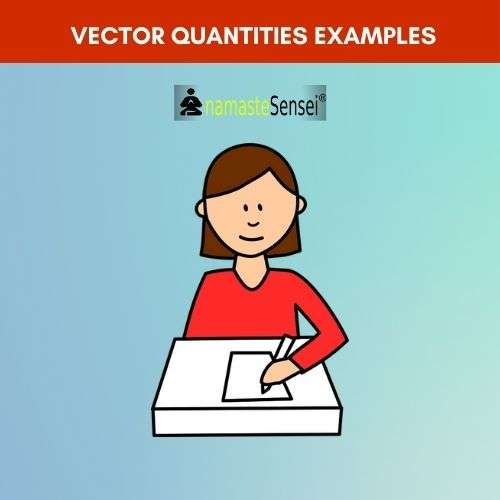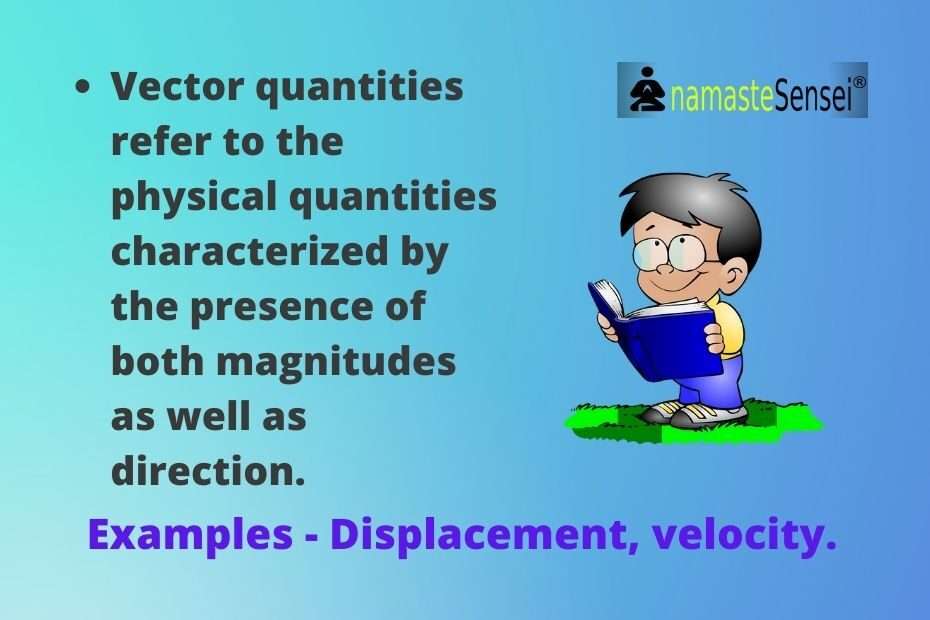-
30 Examples of Vector Quantities

30 Examples of Vector Quantities
Before you read any further it might be a good idea to read about What are Vector Quantities.
Recommended Read: What are Vector Quantities?
In Brief
- Vector quantities refer to the physical quantities characterized by the presence of both magnitudes as well as directions.
30 EXAMPLES OF VECTOR QUANTITIES
Below are the 30 Examples of Vector Quantities in physics.
- Displacement
- Velocity
- Acceleration
- Force
- Momentum
- Torque
- Electric field
- Angular Displacement
- Wave Vector
- Current density
- Drag
- Impulse
- Magnetic field
- Magnetic Flux
- Gravitational field
- Angular velocity
- Angular acceleration
- Angular momentum
- Linear Momentum
- Dipole moment
- Jerk
- Weight
- Buoyant Force
- Thrust
- Magnetic dipole moment
- Electric dipole momentum.
- Magnetization or Magnetic force.
- Polarization
- Electric Displacement
- Poynting Vector
-
30 Examples of Vector Quantity Explained

List of Vector Quantities
Following are the vector quantities:
- Displacement
- The change in the position of a moving body in a particular direction is called its displacement or the shortest distance between the final and the initial positions of a body is called displacement. It is generally denoted by D or X. Displacement is a vector quantity.
- For example- If an object moves from A position to B, then the object’s position changes.
- Velocity
- The distance traveled by a body in a particular direction in a unit of time is called its velocity. velocity is a vector quantity mark.
- SI unit for velocity is a meter per second (m/s).
- For example, the speed of a car traveling north on a highway, or the speed a rocket travels after launching.
- Acceleration
- The time rate of change of velocity of a body is called acceleration.
- Acceleration = Change in Velocity / Time taken
- SI unit for accleretaion is meter per second square (m/s2).
- For example, the speed of a car traveling north on a highway, or the speed a rocket travels after launching.
- Force
- Force is a push or pull that changes or tends to change the state of rest or of uniform motion, the direction of motion, or the shape and size of a body.
- Force is a vector quantity.
- The SI unit of force is Newton. It is denoted by N.
For example, a force of 5 Newton may be described as 5 N.
- Momentum
- The product of the mass of a body and its velocity is called the momentum of the body
- It is generally denoted by ‘p’.
- SI unit of momentum will be kgm/s-1.
- Torque
- Torque is a measure of the force that can cause an object to rotate about an axis.
- Torque is commonly denoted with a capital “T”. It is spelled as (tau).
- SI unit of torque is newton meter (Nm)
- Electric field
- The electric field is the ratio of force per unit charge. Since, force is a vector quantity, electric field is also a vector quantity. It is denoted by ‘E’.
- The SI unit of the electric field is volts per meter (V/m).
- Electric Field (E) = Force(F) / charge(q), where E is the strength of the electric field, F is the electric force, and q is the test charge that is being used to “feel” the electric field.
- Angular Displacement
- The angle subtended at the center of a circle by the initial and final positions of a body moving along the circumference of a circle is called angular displacement of the body.
- The angular displacement is denoted by radian (θ).
- Wave Vector
- A wave vector (also spelled wavevector) is a vector that helps describe a wave. Like any vector, it has a magnitude and direction.
- Current Density
- Current density is a vector quantity having both a direction and a scalar magnitude.
- The current density vector is defined as a vector whose magnitude is the electric current per cross-sectional area at a given point in space, its direction being that of the motion of the positive charges at this point.
- It is denoted by the letter ‘J’.
-
J = I / A, where, I denote the current flowing through the conductor in Amperes, A denotes the cross-section area in m2 Current density is expressed in A/m2
- Drag
- Drag is a force and is, therefore, a vector quantity having both a magnitude and a direction.
- Impulse
- The force which acts on a body for a very short time but produces a large change in the momentum of the body is called an impulsive force. It is a vector quantity.
- The impulse of a force acting on a body is equal to the product of the force and the time for which it acts on a body.
- Impulse = Force × time.
- SI unit of impulse is newton-second kg-m/s.
- Magnetic Field
- Any object experiences forces when placed in a magnetic field. Just like a vector quantity, a magnetic field is described with both magnitude and direction. Thus the magnetic field is a vector quantity.
- Magnetic Flux
- Magnetic flux depends on two quantities – Magnetic field and Area. Both of these components are vector quantities.
- SI unit of magnetic flux is weber(Wb). it is a vector quantity.
- Gravitational Field
- As gravitational field strength consists of force, and as force is a vector quantity, it naturally makes it a vector quantity.
- The gravitational force or the weight acting on a mass m, in the gravitational field 𝑔, is given by: 𝐹 = m𝑔.
- Angular Velocity
- The rate of change of the angular displacement (θ) with time (t) is called angular velocity.
- It is denoted by the Greek letter ω, sometimes Ω (omega).
- The unit of Angular Velocity (ω) is radian per second (rad/s or rad s-1)
- For example, a roulette ball on a roulette wheel, a race car on a circular path.
- Angular Acceleration
- The rate of change of angular velocity is called angular acceleration. It is a vector quantity.
- Angular Acceleration is denoted by alpha (α).
- The formula for Angular acceleration (α) = Angular Velocity (ω) / Time (t)
- SI unit of angular acceleration is radians per second squared (rad s-2).
- Angular Momentum
- Angular momentum is a vector quantity because it is equivalent to linear momentum (i.e. dependent upon both direction and magnitude).
- Angular Momentum is denoted by ‘L’.
- Angular Momentum(L) = mass(m) * velocity(v) * radius(r).
- Linear Momentum
- Linear momentum is a vector quantity. For a molecule with mass, the linear momentum rises to mass occasions speed, and speed is a vector quantity while mass is a scalar amount. A scalar increased by a vector is a vector. Hence, linear momentum is a vector quantity.
- Dipole Moment
- The electric dipole moment is the measure of the separation of the positive charge and negative charge. The electric dipole moment is a vector quantity.
-
The electric dipole moment (p) is given as p = q x d
q is the charge
d is the distance between the two charges.
- Jerk
- Jerk is a quick, sharp pull, thrust, twist, throw, or it’s like; a sudden movement.
-
It is a vector quantity (having both magnitude and direction).
- For Example – The sudden movement of the train.
- Weight
- Weight is a force that is a vector and has a magnitude and direction. Mass is a scalar.
- Buoyant Force
- The upward force exerted by a fluid on the immersed body is called buoyant force or upthrust.
- The buoyant force is a vector quantity since it has both magnitude and direction which is essential for a vector quantity.
- Thrust
- Thrust is a force, it is a vector quantity having both a magnitude and a direction.
- For Example, Sucking a cold drink through a straw.
- Magnetic Dipole Moment
- The magnetic dipole moment is a vector quantity. A magnetic moment is a quantity that represents the magnetic strength and orientation of a magnet or any other object that produces a magnetic field.
- Electric Dipole Moment
- The electric dipole moment is a vector quantity whose magnitude is equal to the product of charge on one dipole and the distance between them. Its direction is from – q to + q. Electric dipole moment is a vector quantity.
- Magnetization or Magnetic Force
- The magnetic force has both magnitude and direction and thus magnetic force is a vector quantity.
- It either attracts or repels depending upon the polarity of both magnets.
- M = Nm/V where M is the magnetization, N is the quantity of the magnetic moment, m is its direction and V is the volume of the sample.
- Polarization
- Polarization is a vector quantity that is related to the Electric field (also a vector quantity)
- Electric Displacement
- Electric displacement is used in the dielectric material to find the response of the materials to the application of an electric field E.
- In Maxwell’s equation, it appears as a vector field.
- The SI unit of electric displacement is Coulomb per meter square (C m-2)
- Poynting Vector
- Poynting vector is a quantity describing the magnitude and direction of the flow of energy in electromagnetic waves.
- Poynting vector is defined as the cross-product of the electric field vector and the magnetic field vector.
- The SI unit of the Poynting vector is the watt per square meter (W/m2)
Congratulations, you have read the complete article about 30 examples of vector quantities. If you have any doubts or queries, feel free to comment below. We will respond as soon as possible.
Or Email Us At [email protected]
Any topic you want us to cover? Let us know.

The topic is very educative and it makes you to understand the program for future reference
Gratitude 🙂
It was really helpful wow I give afull 5stars
We appreciate your concern. Thank you 🙂
What is momentum
Momentum is a property of an object that helps describe how much it is moving. If you think about an object as being like a ball, momentum would describe how difficult it is to stop the ball from moving or to change its direction.
A simple example to understand momentum is to imagine a bowling ball and a feather. If you were to drop both, the bowling ball would hit the ground much harder than the feather because it has more momentum (mass x velocity). This is because even though the feather is lighter, it falls more slowly due to air resistance, which means its velocity is lower.
The formula for momentum is given by:
p = mv
Where p is the momentum, m is the mass of the object, and v is its velocity. The velocity of the object is a vector quantity and has both magnitude and direction. Therefore, momentum is also a vector quantity and has both magnitude and direction.
The unit of momentum is usually a kilogram meter per second (kg m/s) in the SI (International System of Units) system of units. This unit of measurement is also sometimes referred to as Newton-seconds (Ns).
If you still have any doubts feel free to ask.
What is Torque
Torque is a measure of the turning or twisting force that can cause an object to rotate around an axis
Think of a door that you push or pull to open or close. When you apply force to the door handle, you create a torque that makes the door rotate around its hinges.
I hope it is clear now
Regards..